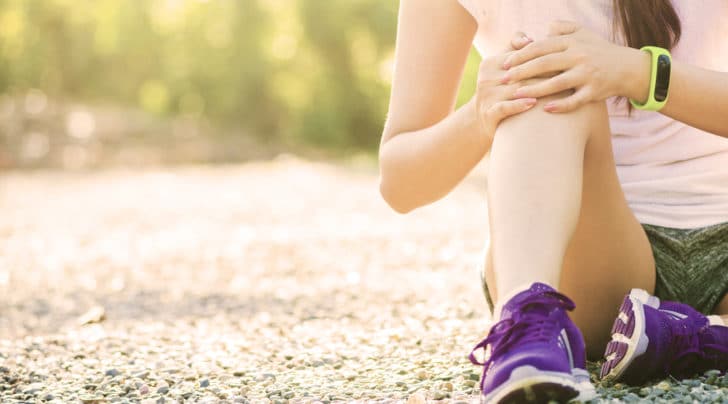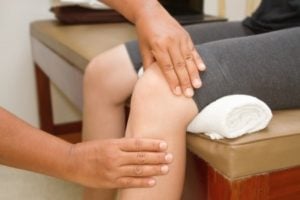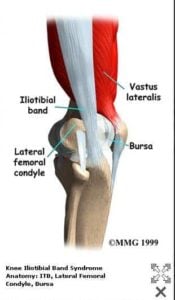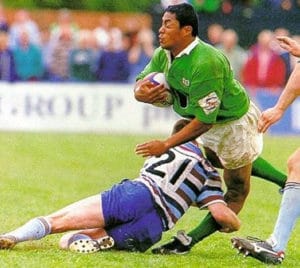Wjy People Find Knee Flexion Funny

Why does the exterior of my knee injure ? Lateral articulatio genus pain is pain on the outside of your knee. The location of your human knee pain can requite you lot a clue about what might be bothering yous. Lateral knee pain is a common location for overuse running injuries. Lateral knee pain is also mutual after an injury in turning or twisting sports. Outer knee pain could also occur without any injury at all. Pain on the outer side of the articulatio genus might exist accompanied by swelling, clicking or popping. Depending on the location of your pain, the cause of your pain, and the associated symptoms we are usually able to decide what the cause of your pain is and what handling will exist necessary.
Most Common Causes of Lateral Knee Hurting:
- lateral meniscus tear
- popliteus tendinitis or instability.
- ITB syndrome
- proximal Tib-fib Joint injuries
- lateral hamstring injury
- lateral collateral ligament injury
Lateral Meniscus Tears:
 The lateral meniscus is one of the two cartilage discs in our knee joint. The lateral meniscus serves as a absorber or shock cushion. Meniscus tears tin can occur due to sports injuries or clothing and tear. Medial meniscus tears, or tears of the meniscus on the inner side of her human knee is more mutual than lateral tears. Tears of the lateral meniscus tin cause pain on the outer side of the knee joint. Depending on the type of tear y'all have it could cause snapping, popping, or fifty-fifty locking. On occasion the entire meniscus will flip over into the middle of the knee due to a unique type of tear called a bucket-handle tear. With bucket-handle tears, in add-on to having hurting on the outer side of the knee, y'all will likely discover that the knee is hard to fully straighten. Many tears of the lateral meniscus tin be safely observed and do not require surgery. Some of these tears might fifty-fifty heal themselves. On occasion people have unstable "radial tears" of the lateral meniscus which might respond well to a repair where the ends of the tear are sewn dorsum together. Almost people with lateral meniscus tears will experience improvement in their pain and function with time and a structured physical therapy programme. On occasion surgery will be necessary. Just this should be clear, this is a quality of life decision. Surgery on the lateral or outer side of the articulatio genus for a meniscus tear is not well tolerated past the knee joint. Many people are told that lateral meniscus surgery can prevent arthritis from occuring. That'due south not true. Peradventure if the torn edges are sewn together we might prevent arthritis from progressing, but if the torn pieces are removed then the lateral compartment often becomes arthritic fairly apace. Lateral meniscus surgery, other than a suture repair should exist avoided if possible to minimize the risk of developing rapidly progressive arthritis.
The lateral meniscus is one of the two cartilage discs in our knee joint. The lateral meniscus serves as a absorber or shock cushion. Meniscus tears tin can occur due to sports injuries or clothing and tear. Medial meniscus tears, or tears of the meniscus on the inner side of her human knee is more mutual than lateral tears. Tears of the lateral meniscus tin cause pain on the outer side of the knee joint. Depending on the type of tear y'all have it could cause snapping, popping, or fifty-fifty locking. On occasion the entire meniscus will flip over into the middle of the knee due to a unique type of tear called a bucket-handle tear. With bucket-handle tears, in add-on to having hurting on the outer side of the knee, y'all will likely discover that the knee is hard to fully straighten. Many tears of the lateral meniscus tin be safely observed and do not require surgery. Some of these tears might fifty-fifty heal themselves. On occasion people have unstable "radial tears" of the lateral meniscus which might respond well to a repair where the ends of the tear are sewn dorsum together. Almost people with lateral meniscus tears will experience improvement in their pain and function with time and a structured physical therapy programme. On occasion surgery will be necessary. Just this should be clear, this is a quality of life decision. Surgery on the lateral or outer side of the articulatio genus for a meniscus tear is not well tolerated past the knee joint. Many people are told that lateral meniscus surgery can prevent arthritis from occuring. That'due south not true. Peradventure if the torn edges are sewn together we might prevent arthritis from progressing, but if the torn pieces are removed then the lateral compartment often becomes arthritic fairly apace. Lateral meniscus surgery, other than a suture repair should exist avoided if possible to minimize the risk of developing rapidly progressive arthritis.
Popliteus Tendinitis
Popliteus tendinitis/tendinosis or instability is an nether-diagnosed and over-looked diagnosis. Many MRI reports will not focus on the the popliteus, but they should. Many athletes with popliteus bug tin exist spared unnecessary surgery if the diagnosis is accurately made. The popliteus tendon is located on the outer side of the articulatio genus. It is a very minor musculus and small tendon however it plays an important office in maintaining stability of the knee. The popliteus can be injured due to trauma or sports injury. More commonly, it will bother you as a event of chronic repetitive stress. Pain due to popliteus tendinitis is on the outer side of the knee and tends to be worse with twisting and turning maneuvers. It does not usually cause snapping or popping, and swelling is not mutual. Popliteus Tendinitis usually creates a very distinct small area on the outer side of the knee which volition be tender to touch. An MRI will often see evidence of inflammation around the popliteus tendon or degeneration of the tendon itself (tendinosis). Oftentimes the pain volition subside with a change in sure activities and perhaps with anti-inflammatories. Concrete therapy can be helpful as well. On occasion nosotros utilize an ultrasound machine to inject the area around the tendon with an anti-inflammatory. Surgery for Popliteus Tendinitis is rarely necessary.
ITB Syndrome Friction Syndrome

Iliotibial band syndrome or ITB syndrome unremarkably occurs in runners. It is most common in long distance runners. ITB syndrome might also occur anyone who is training vigorously. On occasion we will see cyclists with ITB syndrome still, runners brand up the majority of people we see who suffer from this. For the longest time referred to this equally ITB friction syndrome. It was felt that the ilotibial band was rubbing against the bottom of the femur which led to a form of tendinitis. It is non really of the tendon that is the issue in ITB syndrome. The pain in ITB syndrome is usually due to an inflamed bursa, or minor fluid-filled sac, which sits just underneath or deep to the iliotibial band. This bursa becomes inflamed with repetitive activities. Many people besides wrongly concluded ITB syndrome is common because the ITB is besides tight. No research has actually found that the ITB is tight in patients who suffer from iliotibial band syndrome.
We are not quite sure why iliotibial band syndrome occurs. Many causes have been postulated. Some believe information technology may be due to improper shoe habiliment. It might be due to curvature of the road of the surface that you run on. One thing for sure, Information technology syndrome is more common in distance runners.
The bottom line is that ITB syndrome can be a mild annoyance for some, however it might be quite significant pain in others. For most of yous it is a self-limiting process which will go away on its own over a few weeks. Unfortunately for some information technology becomes a long-term consequence. Some people report that a roller is useful to help convalesce hurting. Others written report that shoewear modification and changing the directions of your run can be of benefit. Very little formal research has been focused in this expanse. If the pain is severe nosotros take found that an ultrasound-guided injection into the bursa which lies merely deep to the ITB can be useful. In severe cases which exercise non respond to treatment surgery might become an option, though this is very rare.
Proximal Tib-Fib Joint Injuries
Injuries to the proximal tib-fib articulation are quite rare. When they practice occur, they tend to occur in athletes involved in running sports with significant turning, pivoting, or twisting. An injury to the proximal tib-fib articulation should be suspected if you lot heard a loud pop and felt hurting on the outer side of your knee when you planted and twisted your leg to turn while running. In general you volition find that area to be bloated and quite tender to touch. This is usually because the joint actually dislocated at the fourth dimension of injury. Most of these proximal tib fib joint dislocations will spontaneously reduce and get back into normal position. On occasion the articulation volition remain dislocated. If y'all notice any deformity on the side of the knee then x-rays are indicated sooner rather than afterward. If the proximal tib-fib articulation remains unstable and keeps dislocating and so surgery is indicated to stabilize and repair the joint. During that surgery we normally place a screw through the fibula into the tibia. That volition concur the joint reduced and let information technology to heal. The screw will usually need to be removed prior to return to sports.
Lateral Collateral Ligament Injuries
 Injuries to the lateral collateral ligament non very common. These are typically very high energy injuries. The lateral collateral ligament is very rarely injured in isolation. That means that information technology is generally injured in combination with the ACL or the PCL. Unless you suffered a very significant injury or trauma it is not probable that she was suffered a lateral collateral ligament injury. If yous have pain and instability in the knee feels like it is giving way he should meet sports medicine professional sooner rather than later.
Injuries to the lateral collateral ligament non very common. These are typically very high energy injuries. The lateral collateral ligament is very rarely injured in isolation. That means that information technology is generally injured in combination with the ACL or the PCL. Unless you suffered a very significant injury or trauma it is not probable that she was suffered a lateral collateral ligament injury. If yous have pain and instability in the knee feels like it is giving way he should meet sports medicine professional sooner rather than later.
Hurting on the outer or lateral side of the knee articulation is adequately common. As you can encounter from the list of injuries above at that place are a multitude of causes of pain. Many of these problems respond to nonsurgical management. Return to sports or activities is usually successful after your lateral knee hurting has resolved.
Reader Interactions
chancellorfeent1968.blogspot.com
Source: https://www.howardluksmd.com/lateral-knee-pain-explained/
0 Response to "Wjy People Find Knee Flexion Funny"
Enregistrer un commentaire